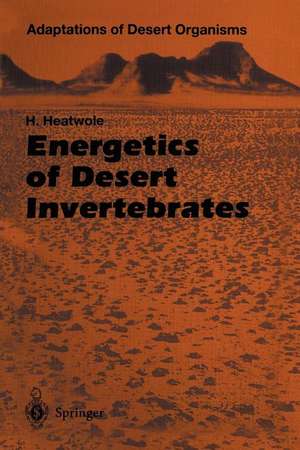Energetics of Desert Invertebrates: Adaptations of Desert Organisms
Autor Harold Heatwole Fotografii de J. L. Cloudsley-Thompsonen Limba Engleză Paperback – mar 2012
The adaptive modes of husbanding scarce energy resources are diverse and lead to an appreciation of the intricate interactions of animals living near their environmental limits.
Din seria Adaptations of Desert Organisms
- 18%
 Preț: 954.14 lei
Preț: 954.14 lei - 18%
 Preț: 948.29 lei
Preț: 948.29 lei - 18%
 Preț: 945.92 lei
Preț: 945.92 lei - 18%
 Preț: 947.35 lei
Preț: 947.35 lei - 18%
 Preț: 1384.44 lei
Preț: 1384.44 lei - 18%
 Preț: 946.10 lei
Preț: 946.10 lei - 18%
 Preț: 1212.68 lei
Preț: 1212.68 lei - 18%
 Preț: 953.82 lei
Preț: 953.82 lei - 15%
 Preț: 632.70 lei
Preț: 632.70 lei - 15%
 Preț: 635.31 lei
Preț: 635.31 lei - 15%
 Preț: 639.25 lei
Preț: 639.25 lei -
 Preț: 382.57 lei
Preț: 382.57 lei - 15%
 Preț: 636.80 lei
Preț: 636.80 lei - 15%
 Preț: 640.24 lei
Preț: 640.24 lei - 15%
 Preț: 641.03 lei
Preț: 641.03 lei - 15%
 Preț: 636.45 lei
Preț: 636.45 lei - 15%
 Preț: 632.37 lei
Preț: 632.37 lei - 15%
 Preț: 637.28 lei
Preț: 637.28 lei -
 Preț: 378.92 lei
Preț: 378.92 lei - 15%
 Preț: 633.53 lei
Preț: 633.53 lei - 15%
 Preț: 693.71 lei
Preț: 693.71 lei - 15%
 Preț: 636.45 lei
Preț: 636.45 lei - 15%
 Preț: 641.53 lei
Preț: 641.53 lei -
 Preț: 388.34 lei
Preț: 388.34 lei -
 Preț: 395.63 lei
Preț: 395.63 lei
Preț: 639.73 lei
Preț vechi: 752.63 lei
-15% Nou
Puncte Express: 960
Preț estimativ în valută:
122.41€ • 128.15$ • 101.29£
122.41€ • 128.15$ • 101.29£
Carte tipărită la comandă
Livrare economică 07-21 aprilie
Preluare comenzi: 021 569.72.76
Specificații
ISBN-13: 9783642646065
ISBN-10: 3642646069
Pagini: 284
Ilustrații: XII, 266 p.
Dimensiuni: 155 x 235 x 15 mm
Greutate: 0.4 kg
Ediția:Softcover reprint of the original 1st ed. 1996
Editura: Springer Berlin, Heidelberg
Colecția Springer
Seria Adaptations of Desert Organisms
Locul publicării:Berlin, Heidelberg, Germany
ISBN-10: 3642646069
Pagini: 284
Ilustrații: XII, 266 p.
Dimensiuni: 155 x 235 x 15 mm
Greutate: 0.4 kg
Ediția:Softcover reprint of the original 1st ed. 1996
Editura: Springer Berlin, Heidelberg
Colecția Springer
Seria Adaptations of Desert Organisms
Locul publicării:Berlin, Heidelberg, Germany
Public țintă
ResearchCuprins
1 Introduction.- 1.1 Energetics.- 1.2 Deserts and Their Environments.- 1.3 The Deserts of the World.- 1.4 Desert Invertebrates.- 2 Foraging: The Acquisition of Energy.- 2.1 Introduction.- 2.2 Optimal Foraging.- 2.3 Sit-and-Wait Foragers.- 2.4 Patterns of Active Foraging.- 2.5 Factors Influencing Foraging.- 2.6 Biotic Interactions and Foraging.- 2.7 Interactions of Factors.- 2.8 Differences Among Ant Colonies in Foraging Activity.- 2.9 Role of Learning and Memory in Foraging and Food Processing.- 2.10 Apportionment of Foraging and other Activities.- 2.11 Foraging Success.- 3 Metabolism: The Expenditure of Energy.- 3.1 Introduction.- 3.2 Metabolism and Temperature.- 3.3 Metabolism and Water.- 3.4 Metabolism and Activity.- 3.5 Metabolism and Body Size.- 3.6 Metabolism and Sex.- 3.7 Metabolism and Life-History Stage.- 3.8 Metabolism and Biological Rhythm.- 3.9 Metabolism and Depth in Ground.- 3.10 Group Effects on Metabolism.- 3.11 Depressed Metabolism as a Desert Adaptation.- 4 Budgeting of Energy.- 4.1 Introduction.- 4.2 Ingestion.- 4.3 Digestion.- 4.4 Assimilation.- 4.5 Maintenance and Activity.- 4.6 Respiratory Quotients.- 4.7 Growth.- 4.8 Reproduction.- 4.9 Egestion.- 4.10 Energy Budgets.- 4.11 Energetics of Different Life-History Stages.- 4.12 Energy Expended in Desert Adaptation.- 5 Storage: The Hoarding of Energy.- 5.1 Introduction.- 5.2 Food Storage.- 5.3 Body Reserves.- 5.4 Agriculture and Animal Husbandry.- 6 Quiescence and Dormancy: Waiting Out Energy Shortages.- 6.1 Introduction.- 6.2 Quiescence and Dormancy.- 6.3 Diapause.- 6.4 Anhydrobiosis.- 6.5 Encystment of Protozoans.- 6.6 Risks of Dormancy.- 7 Migration and Nomadism: Tracking Energy Sources.- 7.1 Introduction.- 7.2 Orthopteran Movements.- 7.3 Other Nomadic Insects in Deserts.- 7.4 Migration on a Microscale.- 8 Community Dynamics: The Flow of Energy.- 8.1 Introduction.- 8.2 Community Structure.- 8.3 Food Webs: Pathways of Energy Flow.- 8.4 Trophic Structure.- 8.5 Quantitative Cycling of Energy and Nutrients.- 8.6 Interaction of Climatic and Biotic Factors in Cycling.- 9 Overview.- References.















